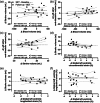Intensified training augments cardiac function, but not blood volume, in male youth elite ice hockey team players
- PMID: 39014554
- PMCID: PMC12053869
- DOI: 10.1113/EP091674
Intensified training augments cardiac function, but not blood volume, in male youth elite ice hockey team players
Abstract
While it is well-established that a period of interval training performed at near maximal effort, such as speed endurance training (SET), enhances intense exercise performance in well-trained individuals, less is known about its effect on cardiac morphology and function as well as blood volume. To investigate this, we subjected 12 Under-20 Danish national team ice hockey players (age 18 ± 1 years, mean ± SD) to 4 weeks of SET, consisting of 6-10 × 20 s skating bouts at maximal effort interspersed by 2 min of recovery conducted three times weekly. This was followed by 4 weeks of regular training (follow-up). We assessed resting cardiac function and dimensions using transthoracic echocardiography and quantified total blood volume with the carbon monoxide rebreathing technique at three time points: before SET, after SET and after the follow-up period. After SET, stroke volume had increased by 10 (2-18) mL (mean (95% CI)), left atrial end-diastolic volume by 10 (3-17) mL, and circumferential strain improved by 0.9%-points (1.7-0.1) (all P < 0.05). At follow-up, circumferential strain and left atrial end-diastolic volume were reverted to baseline levels, while stroke volume remained elevated. Blood volume and morphological parameters for the left ventricle, including mass and end-diastolic volume, did not change during the study. In conclusion, our findings demonstrate that a brief period of SET elicits beneficial central cardiac adaptations in elite ice hockey players independent of changes in blood volume.
Keywords: blood volume; echocardiography; high‐intensity interval training; performance.
© 2024 The Author(s). Experimental Physiology published by John Wiley & Sons Ltd on behalf of The Physiological Society.
Conflict of interest statement
None.
Figures



Similar articles
-
Four Weeks of Intensified Training Enhances On-Ice Intermittent Exercise Performance and Increases Maximal Oxygen Consumption of Youth National-Team Ice Hockey Players.Int J Sports Physiol Perform. 2022 Jul 26;17(10):1507-1515. doi: 10.1123/ijspp.2021-0560. Print 2022 Oct 1. Int J Sports Physiol Perform. 2022. PMID: 35894877 Clinical Trial.
-
Cardiovascular response to exercise in elite ice hockey players.Can J Cardiol. 2004 Jul;20(9):893-7. Can J Cardiol. 2004. PMID: 15266359
-
On-Ice and Off-Ice Fitness Profiles of Elite and U20 Male Ice Hockey Players of Two Different National Standards.J Strength Cond Res. 2020 Dec;34(12):3369-3376. doi: 10.1519/JSC.0000000000003836. J Strength Cond Res. 2020. PMID: 33009345
-
Neuromuscular Adaptations to Short-Term High-Intensity Interval Training in Female Ice-Hockey Players.J Strength Cond Res. 2019 Feb;33(2):479-485. doi: 10.1519/JSC.0000000000001881. J Strength Cond Res. 2019. PMID: 28277422
-
Physiology of ice hockey.Sports Med. 1988 Feb;5(2):99-126. doi: 10.2165/00007256-198805020-00003. Sports Med. 1988. PMID: 3281210 Review.
Cited by
-
The unspecific control of cardiac output during exercise and in (patho-)physiology: Time to get more specific!Exp Physiol. 2025 May;110(5):631-633. doi: 10.1113/EP092578. Epub 2025 Mar 25. Exp Physiol. 2025. PMID: 40134236 Free PMC article. No abstract available.
-
Speed Endurance Training to Improve Performance.Scand J Med Sci Sports. 2025 Jul;35(7):e70091. doi: 10.1111/sms.70091. Scand J Med Sci Sports. 2025. PMID: 40576293 Free PMC article. Review.
-
Exercise echocardiography for improved assessment of diastolic filling dynamics.Exp Physiol. 2025 Jun;110(6):809-820. doi: 10.1113/EP092177. Epub 2025 Feb 9. Exp Physiol. 2025. PMID: 39925003 Free PMC article.
References
-
- Baggish, A. L. , Wang, F. , Weiner, R. B. , Elinoff, J. M. , Tournoux, F. , Boland, A. , Picard, M. H. , Adolph, M. , Hutter, J. , & Wood, M. J. (2008). Training‐specific changes in cardiac structure and function: A prospective and longitudinal assessment of competitive athletes. Journal of Applied Physiology, 104(4), 1121–1128. - PubMed
-
- Billig, S. , Zayat, R. , Ebeling, A. , Steffen, H. , Nix, C. , Hatam, N. , Schnöring, H. , & Derwall, M. (2021). Transesophageal echocardiography in swine: Evaluation of left and right ventricular structure, function and myocardial work. The International Journal of Cardiovascular Imaging, 37(3), 835–846. - PMC - PubMed
-
- Bonne, T. C. , Doucende, G. , Flück, D. , Jacobs, R. A. , Nordsborg, N. B. , Robach, P. , Walther, G. , & Lundby, C. (2014). Phlebotomy eliminates the maximal cardiac output response to six weeks of exercise training. American Journal of Physiology‐Regulatory Integrative and Comparative Physiology, 306(10), R752–R760.. - PubMed
MeSH terms
Grants and funding
LinkOut - more resources
Full Text Sources
